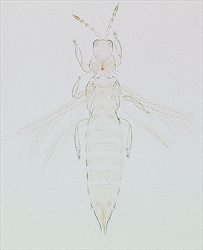
Female
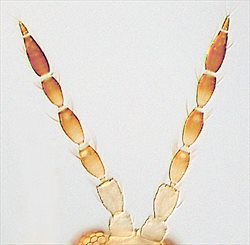
Antennae
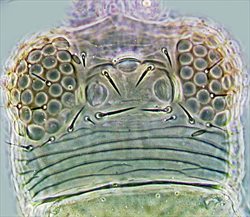
Head
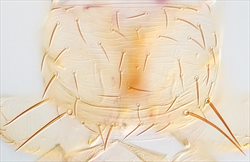
Pronotum

Antenna
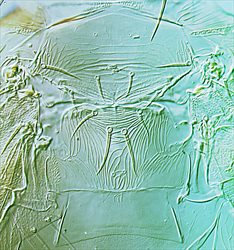
Meso & metanota
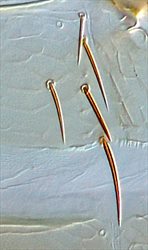
Tergite II margin
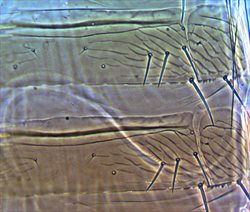
Abdominal tergites and pleurotergites
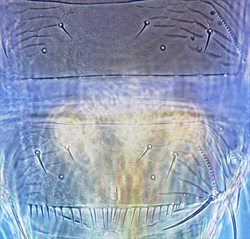
Tergites VII-VIII
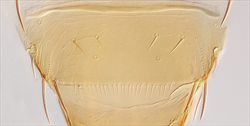
Tergite VIII
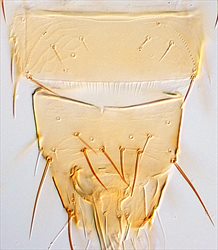
Male tergites VIII–IX
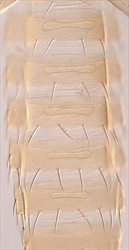
Male sternites II-VII

Fore wing
Both sexes fully winged. Body and legs yellow, major setae light brown; antennal segments IV–V brown distally, VI–VII brown; fore wings pale. Antennae 7-segmented; segments III–IV each with short forked sense cone; VII short. Head with 2 pairs of ocellar setae; pair III no longer than distance between 2 ocelli, arising just outside ocellar triangle; postocular setae pair I slightly longer than ocellar setae III, pair II minute. Pronotum with 2 pairs of long posteroangular setae; posterior margin with 3 pairs of setae. Mesonotum with paired anterior campaniform sensilla. Metanotum with irregular longitudinal lines converging at the posterior margin, at anterior with curving transverse lines; median setae arising behind anterior margin; campaniform sensilla present. Fore wing first vein usually with 3 setae on distal half; second vein with row of about 15 setae. Abdominal tergite II with 4 lateral marginal setae; tergites V–VIII with paired ctenidia laterally, on VIII posteromesad to spiracles; tergite VIII posteromarginal comb complete, microtrichia long and slender, discal setae S1 clearly shorter than S2; pleurotergites without discal setae, without microtrichia on sculpture lines or on posterior margin; tergite IX with 2 pairs of campaniform sensilla, X with median split. Sternites without discal setae; median setae on VII arising in front of margin.
Male smaller than female; tergite VIII posteromarginal comb complete medially but microtrichia weak and irregular; sternites III–VII each with transverse pore plate.
The genus Thrips is the second largest genus in the Thysanoptera, and currently includes, worldwide, over 290 species. All members of genus Thrips lack ocellar setae I on the head, and they all have ctenidia on tergite VIII posteromesad to the spiracles. Other characters, such as number of antennal segments, number of setae on the fore wing veins, and number of discal setae on the sternites are variable between species (Palmer, 1992; Nakahara, 1994; Mound & Masumoto, 2005). Thrips palmi is remarkably similar in structure to T. flavus, but that species has ocellar setae III arising within the ocellar triangle just behind the first ocellus, and the longitudinal sculpture on the metanotum does not converge before the posterior margin. T. palmi is also similar to Thrips alni, although that species has the median pair of setae on tergite VIII of females as long as the lateral pair of setae and the pore plate is absent on sternite VII of the males.
Feeding and breeding on the leaves and in the flowers of its host plants, with a particular prevelance on Cucurbitaceae and Solanaceae in commercial production. Although called the Melon Thrips, it is polyphagous and causes damage to plant species in a wide range of families.
Originally from Southeast Asia, the Melon Thrips is an invasive pest species that has been widely transported around the tropics and sub-tropics by the international trade in plants and plant products. It is not established in Britain, but is a quarantine-listed pest species that is frequently intercepted at airports, by the Plant Health Service of England and Wales, on plants and produce imported from the tropics (Collins, 2010a). A population was present within a commercial glasshouse in Sussex for at least a year (2000-01) and a single adult female was found under glass in Yorkshire in 1999, but on both occasions the outbreak was successfully eradicated (Cannon et al., 2007; Collins, 2010a). This species is a major crop pest in various tropical countries. It is not present in Europe, though a small number of populations have been found (in the Netherlands, Portugal, Germany) and eradicated.
THRIPIDAE - THRIPINAE
Thrips palmi Karny
Thrips palmi Karny, 1925: 10
Thrips clarus Moulton, 1928: 294
Thrips leucadophilus Priesner, 1936: 91
Thrips gossypicola Priesner, 1939: 41
Chloethrips aureus Ananthakrishnan & Jagadish, 1967: 381
Thrips gracilis Ananthakrishnan & Jagadish, 1968: 361
Cannon RJC, Matthews L, Collins DW, Agallou E, Bartlett PW, Walters KFA, Macleod A, Slawson DD & Gaunt A (2007) Eradication of an invasive alien pest, Thrips palmi, in the UK with a review of control options for this pest. Crop Protection 26: 1303–1314.
Collins DW (2010a) Thysanoptera of Great Britain: a revised and updated checklist. Zootaxa 2412: 21–41.
Mound LA & Masumoto M (2005) The genus Thrips (Thysanoptera, Thripidae) in Australia, New Caledonia and New Zealand. Zootaxa 1020: 1–64.
Nakahara S (1994) The genus Thrips Linnaeus (Thysanoptera: Thripidae) of the New World. United States Department of Agriculture. Technical Bulletin 1822: 1–183.
Palmer JM (1992) Thrips (Thysanoptera) from Pakistan to the Pacific: a review. Bulletin of the British Museum (Natural History) Entomology Series 61 (1): 1–76.